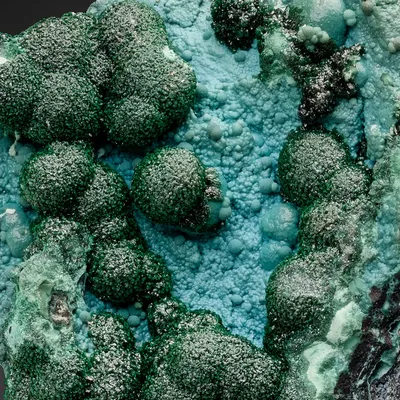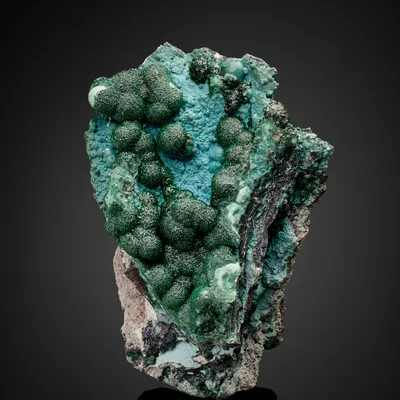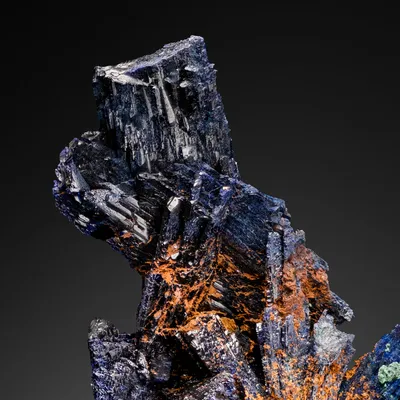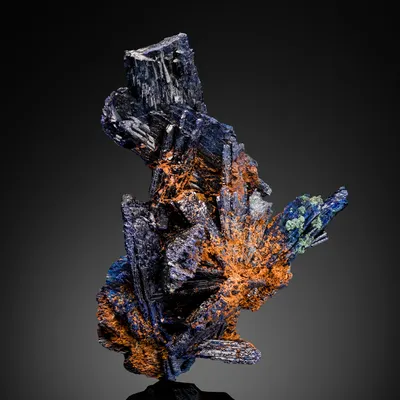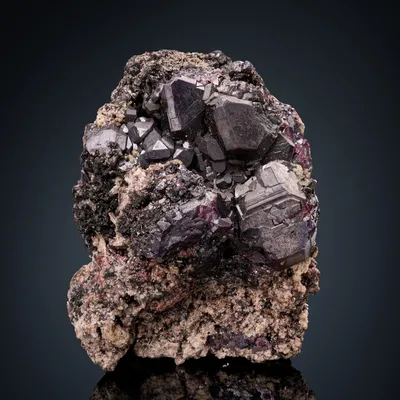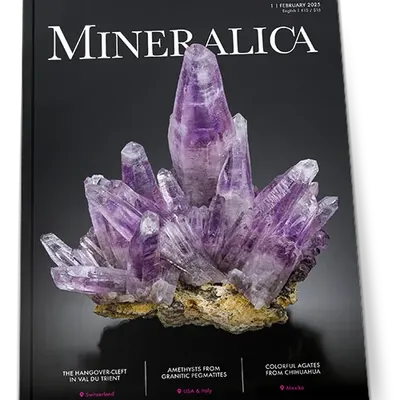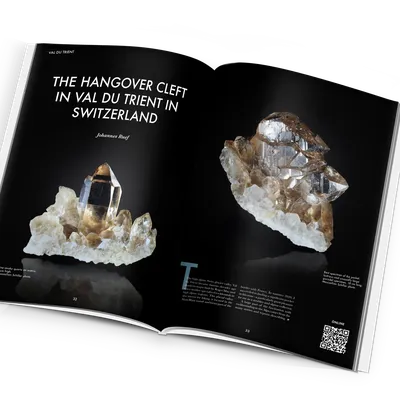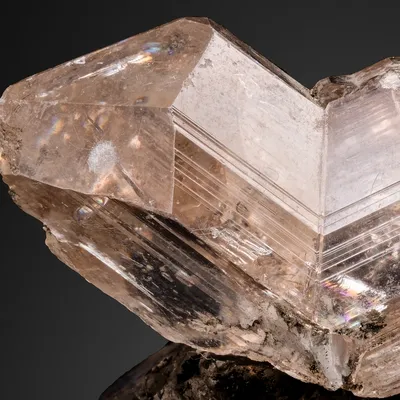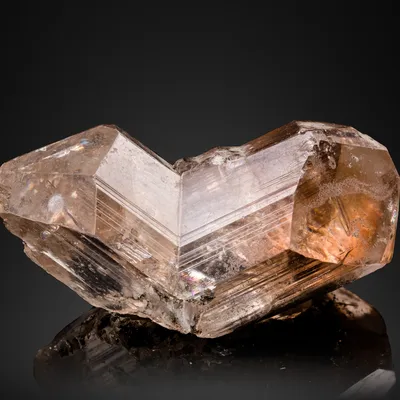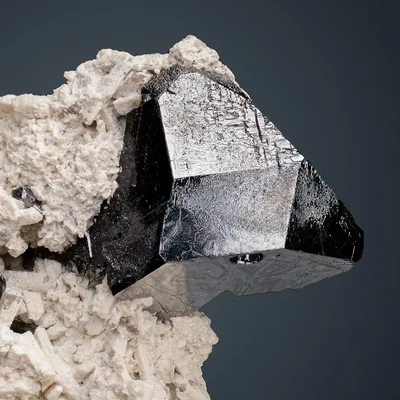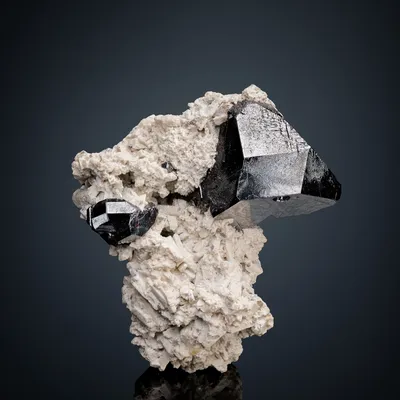The Great Apatite Cleft at Finagl Mountain
In the summer of 1994, Erwin Burgsteiner discovered an intersting cleft with many excellent pericline-adular sphene and apatite specimens at the Großer Finagl in the Untersulzbachtal in Austria.

The Discovery of the Cleft
In the last days of July 1994, I wandered through the extremely steep rock formations of the Großer Finagl, which had been the subject of many interesting mineralogical reports in recent years. The clefts in the amphibolite were always well formed and with interesting mineralisation: Apatite, Prehnite, Quartz, Adularite, Pericline and Sphene. On my previous walks through this area I had discovered a few smaller fissures, but never a really good one. It seemed to be the same this time and I was already getting used to the idea of descending into the valley soon, as the sun was already low. I wasn't really disappointed when I arrived home tired because not finding any fissures was much more common than being successful.
The next day, I a collector from Germany visited me. He told me that he had been to Finagl and had found beautiful stones in a cleft there. He could not show me anything but he described his finds so well that I decided to make another attempt. One day later, I climbed the long and steep path via the Wiesegg hut up to the amphibolite rocks of the Großer Finagl. I passed the freshly worked cleft of my guest but could not imagine that really good material had been found here.
The morning passed quickly without any crystalline signs and there was little to see in the afternoon either. I was still in the summit region, the desire to search had already faded and I still had to plan at least three hours to get home. At around 2600 m above sea level, I crossed a steep ridge. Suddenly I noticed a small piece of adular between larger boulders, which suggested a good cleft by the way it was formed. However, such pieces of adular rarely fall out of a cleft on its own. Nevertheless, the small piece of adular gave me a new boost of energy and I wanted to find out where it came from and at least take a look at the exploited cavity. I soon thought I had discovered the place of origin and headed for a massive Quartz vein at the top of the gully. But there was no sign of a cleft here. Only when I had reconstructed the possible fall lines with my eyes did I see the trace of a Quartz band above a slightly overhanging rock head, but with the best will in the world I couldn't imagine that a collector had ever worked in this extreme and overhanging wall. I just wanted to find out and climbed up a narrow, grassy ledge on the left. There I found a narrow cleft with small, numb Sphenes and insignificant skeletal Quartz crystals. The cleft could no longer be above this rocky head, so I set off on the descent. The climb wasn't easy, and the view down was particularly impressive. Then I was back where I had discovered the small Adular section. I persisted and made a second attempt. I climbed out on a fairly narrow ledge to the hollow wall and suddenly stood in front of a large, already cleared cleft. The side walls were densely covered with periclines and adulars. On the floor, there was a small cone of rubble made of stones, chlorite sand and pieces of grass. The chasm had probably been cleared out, then the upper areas had been looked at and the rubble and pieces of turf had fallen down, but they had not been cleared away. On the tiny ledge in front of the cleft was beautiful green chlorite sand on which the rain had washed away small fragments of Sphene and Spatite. There was not much room to work (about one square meter), as the wall immediately in front of it dropped a hundred meters overhanging. On the rubble pile, I noticed several old newspapers that had been softened by the rain and could still make out the year 1991 on them. As there were no tools to be found (which meant that the finders had stopped working on the cleft), I assumed that I had simply arrived a few years too late. I rummaged through the rubble somewhat listlessly, feeling that there could not be too much left here. However, I wanted to take at least some of the leftovers with me as I had not found anything better that day. Now, to my surprise, I held a head-sized piece in my hands, which showed a clear apatite surface coated in hard chlorite sand. I assumed that my predecessors had overlooked this specimen, or perhaps they had had better things to carry, packed up and finally started my descent.
When I hosed down the piece I had brought home with me, it revealed three six-centimetre apatite crystals between chlorite-dusted periclines (a piece that is still in my collection today). Nevertheless, I still believed that it was an overlooked piece and that the cleft had already been exploited. That is why I was in no hurry to visit the site again.
The Surprise
It was only after a week and a half - in the meantime I visited another area without success - before I was drawn back to Finagl. I started to clear away all the old rubble but apart from fragments there was nothing to take with me for the time being. After half an hour's work, I noticed to my delight that the chlorite further down had not been completely cleared away. The uppermost chlorite layer was hard (the first finders had probably assumed that this was the end of the cleft) but the deeper I dug, the softer and sandier it became. Despite this, I was still of the opinion that it was just an overlooked corner of the cleared out cleft.
However, my interest immediately increased when I pulled a mountain-fresh adular specimen with yellow-green sphenes out of the now loose chlorite sand. Immediately afterwards, I was also able to recover some bizarre pericline adular specimens. Could this be a new part of the cleft? It slowly began to dawn on me: This must be the moment I had been waiting for and which every collector dreams of! I carefully felt around with my bare hands and kept lifting new, hand-sized pieces out of the loose chlorite sand. My heart was pounding wildly because I hadn't made such a good find for a long time. By early afternoon, a considerable number of beautiful specimens had accumulated on the newspaper. Overjoyed, I packed up the specimens, deposited my tools and headed down the steep flanks into the Untersulzbachtal, which was quite an effort with my heavy backpack.
The very next morning - the weather gods were really kind to me as there were to be more thunderstorms for the next few days - I was back at the entrance to the cleft. This time I had taken a fine-mesh sieve with me so that I wouldn't miss even the small things. Piece by piece I pulled it out, the chlorite sand trickled down the rock face. This run-off sometimes even became a bit of a problem, because when the weather was fine in the late morning, the upwind was so strong that it blew the tiny chlorite grains sharply into my face and I could only see with difficulty or even had to turn away.
Now a specimen about the size of my head came to light, so that my backpack was soon filled again. Digging up and recovering such treasures were always wonderful moments, and when the specimens stood in the sun for a while, the chlorite sand dried, trickled to the ground and gave a hint of the beauty of the piece. I was blissfully happy, but the small space forced me to silently enjoy my happiness, as dancing would have been too risky.
The next day I was accompanied by Hans, an friend from Vorarlberg. I was very happy about that because the excitement is even greater with two people, and two backpacks could carry more specimens. Besides, he had never been to the opening of a cleft before. Of course, two people had very little room to stand and it would actually have been smarter if I had taken a rope with me to secure myself but at the time I knew no fear and assumed that someone else felt the same.
So I got back to work while Hans carefully sifted through the crevice sand. Many Sphenes lay loose in the sand. Suddenly I held the first Apatite in my hand - smooth and sharply polished. A few times I enjoyed feeling the smoothness and perfection of nature with my fingertips. Now I had to be extremely careful and restrain my own impatience and curiosity, removing layer after layer of sand evenly like an archaeologist to not risk breaking or damaging the minerals by pulling them out without restraint. This was immediately followed by two beautiful, yellow, intergrown Apatite slices, a fist-sized aggregate on which Sphenes had also found a place. The Apatite crystals showed signs of dissolution at the edges. The find exceeded our expectations by far. In addition, the number of Sphene pieces on the western side of the fissure increased more and more. Every time there was enough material in front of the fissure, it was one of the most difficult things to do at the end of the day because you could feel that every new hold could bring something surprising to light. What would the next few days bring?
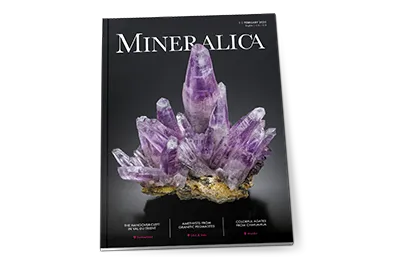
The new premium magazine for mineral collectors
4 issues per year – packed with fascinating finds, expert knowledge, and collector passion. The first bilingual magazine (German/English), including full online access.
Explore subscriptionHowever, we were less pleased about the approaching storm front, the rumbling of the thunder made us pack up quickly and descend back down the valley. The rain made the lichen-covered rocks extremely slippery and dangerous. We found some shelter under a stone and the sun was already shining again in the forest. Hans wanted to take a break the next day, but that was out of the question for me, even though my shoulders and knees were already aching.
The ascent and descent were always very exhausting as one route took an average of three and a half hours, and up to five hours with the really heavy stones and many breaks. The Finagl slope also falls steeply and evenly down to the foot of the mountain and never allows you to take a breathe, not even the serpentines from the hunting lodge to the valley path has a flat section that is easy on your strength. I later chose the route from the Habachtal as it seemed a little more varied and comfortable, even if I had to descend about a hundred meters back into the Untersulzbachtal and climb back up again in the evening.
The Best Specimen
This time I worked on the western, downhill side of the cleft, where there were relatively many loose sphenes (up to 1.5 cm). The sieving took a lot of time, and the working time was precious, because you had to be constantly on guard against thunderstorms, which sometimes forced you to descend prematurely. A slab suddenly blocked the way down, or was that already the bottom of the chasm? As I could feel and see Perikline on it, I worked very carefully. I hadn't needed any tools yet, apart from the small piton. Finally, the slab lay free in front of me and I was able to lift the 30 kg piece in front of the fissure and examine it. To my delight, I saw a large area of apatite shining out of the thick chlorite mantle, so I immediately assumed that it could be a special piece. I wanted to leave the chlorite sand on the specimen for transportation, as it had already protected the minerals for many millions of years and would continue to do so on the way down into the valley. As it was time for the descent, I stowed the specimen in the large rucksack, padded it with foam and crumpled newspaper and started to climb down. The storm front was already pushing the dark clouds against the summit of the Finagl and before the rain set in, I wanted to at least have the challenging climbs behind me. I actually made it to the steep grassy slopes above the Wiesegg hut. I had to hurry, on the other hand I couldn't take a careless step on this slippery grassy slope overgrown with small alder bushes, while there were repeated flashes of lightning and almost simultaneous crashes. Suddenly I started to slide and hurtled about ten meters through the alder bushes. I was still thinking about my precious cargo in my rucksack and twisted so that the rucksack didn't hit the ground. Fortunately, I managed to catch a branch where I slowed down and came to a halt again. My knees were weak, but now I had to be even more careful, even if a quick descent out of the electrically charged zone was advisable. I finally reached the forest area and was able to wait under the canopy of the Wiesegg hut until the storm had moved on.
I was curious to see what was hiding under the chlorite sand on the specimen. When I got home, I unwrapped the heavy stone from its protective covers and carefully hosed down the group, as the apatites can be very sensitive. I had not been prepared for what I was about to see! The absolutely most beautiful part of the chasm lay before me! Massive, chlorite-dusted periclines stand like on a bowl, behind them lies a dark bulge of chloritized, small adularia - good for the contrast. Small sphenes are scattered over it again and again. In the most ideal place behind the chlorite bulge are three 8 cm large, yellow, highly lustrous apatites with beveled surfaces. Fortunately, they had not come loose and despite their size and the slide in the thunderstorm rain, I had managed to bring the specimen down to the valley unharmed.
Deeper and Deeper
During the time that followed, I dug deeper and deeper into the mountain, vertically downwards. Soon there was nothing more I could do on my own because I could not get the chlorite sand up any further. Some of my fellow rockhunters accompanied me (Erich, Axel, Günther, Franz). We quickly converted a plastic canister, attached a cord to it and thus had a practical elevator. One of us sat at the bottom of the crevasse and filled the canister, the second pulled it up, inspected and sorted the stones. Many interesting specimens followed, but the apatites were often dissolved. At the end of the summer, the fissure had a depth of around 6.5 meters (including the old fissure area), a width of 1.2 meters and a length of 2.5 meters. This evenly wide tube stretched vertically downwards, with excellent periclinal steps in the chlorite sand and another large bulge in the lowest section. I wanted to leave a section on the mountain side for next year, and I also wanted to leave a lot in front of the crevasse over the winter, as school was about to start. On a clear foehn day, my former climbing partner Herbert and two friends climbed up to the "hole" with me and Herbert made a half-hour video to document this find.
The Second Year
When the place was free of snow again in spring 1995, I could not continue for the time being because a thick block of ice had closed the crevasse. But I still had enough to carry down anyway. The heaviest slab (I call it a "butterfly" because of its shape), formed like a bowl with small sphenes, the edges lined with periclines and with the most beautiful apatites on its back - this specimen I had to balance down on a crawl. It took me almost the whole day. It wasn't until the end of July that I was able to search further down the narrow tube, but there were no more spectacular pieces. Together with my friend Vinzenz, I uncovered the area on the mountain side and we found another large Apatite, as well as snow-white pericline with small adulars.
I soon found out who discovered the cleft right before me. The young finders of this cleft explained to me that they had not thought that the fissure could go this deep and had therefore finished their work.
The entire paragenesis thus comprises: Quartz (mostly formed as skeletal quartz), Apatite, Sphene, Pericline, Adularite, Calcite (frequently already etched away and often only recognizable from the negative forms), Zoisite (up to 5 mm), Pyrite (few and in the size of a few millimetres) and masses of Chlorite. It should be mentioned that the plates of leached Amphibolite bent by strong tensile and compressive forces are a characteristic feature of this cleft. It is often the case that very thin, curved slabs of Periclase and Adularia are covered on both sides.
Before the bad weather of the summer of 1995, with heavy snowfalls, my two sons Hannes and Andreas climbed up with me once again to carry down the tools I had deposited and which I had hardly used anyway. We left all kinds of useful specimens behind, maybe someone would be happy one day. Today, the exertions are long forgotten and I am very, very grateful that I was so lucky to be able to find and exploit such a large cleft with excellent minerals. It was undoubtedly a great moment in my collecting career and the best specimens are in my collection.
I remember two critical moments in connection with the cleft in the steep terrain, but fortunately they ended well. Once I wanted to put a piece weighing about 30 kilograms in front of the cleft, saw the large Apatites on it but got my left foot caught on the entrance to the cleft and stumbled. It was only with great difficulty that I was able to bring myself and the large stone to a halt, just before it could fall down the mountain.
The situation was just as tingly when I tried to stand up with my heavy backpack. At that moment - just as I had stood up again - the left strap snapped and the weight immediately shifted downhill. I was terrified and thankfully reacted correctly by immediately sitting back down so that the backpack was stable again in the chlorite sand that had been thrown out.
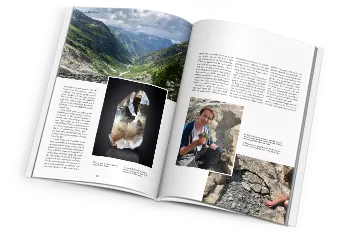
The must-have for everyone who collects minerals
Mineralica is your premium collector’s magazine – made exclusively for lovers of minerals and fossils. In print, bilingual, and with full access to the complete online library.
View issue previewHow Things Can Change
I had an interesting encounter on one of the last hikes in 1994. On the descent to the Wildalm I saw the hunter in charge and knew that he was not a great friend of stone hunters. But I could not avoid him and so we met. Even before we greeted each other, he began to rant wildly about the stone hunters - I only listened and did not say anything back. When the tirade of foul language subsided, I nodded in agreement and even agreed with him on some things. He calmed down, we descended to the mountain pasture together, he confided his family history to me and finally he invited me for a beer at the hut. We had a second beer, the bad mood had passed and as I was getting ready to go home, he stood up and extended a serious invitation. I should definitely go bear hunting with him in Canada!














